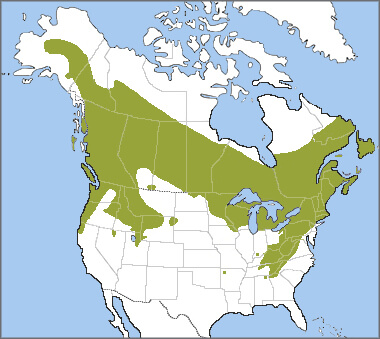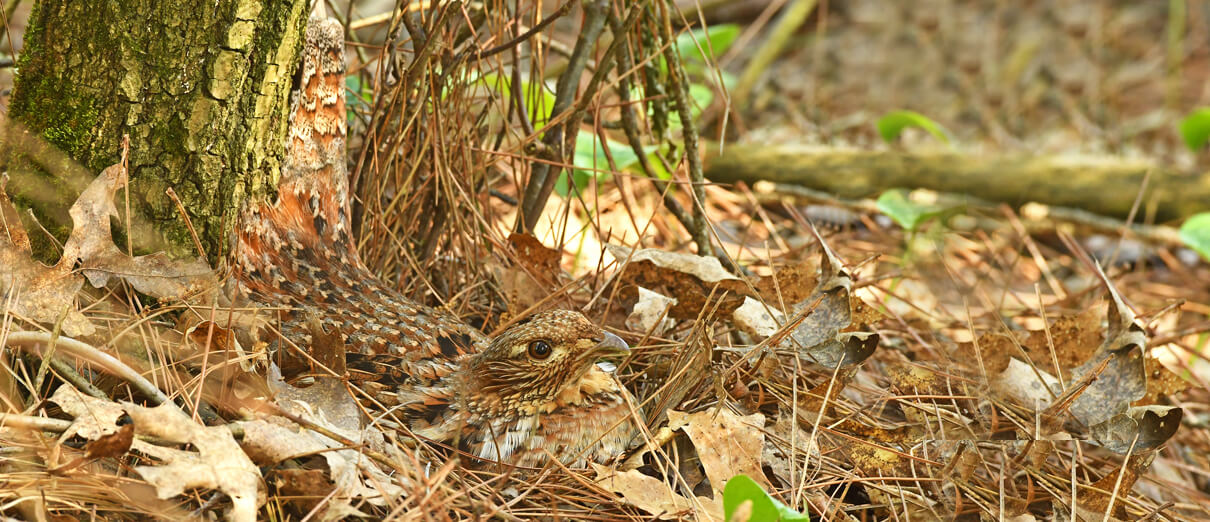
Ruffed Grouse range map by ABC.
One of North America's 12 native grouse species — a group that includes the Greater Sage-Grouse, Dusky Grouse, and Greater Prairie-Chicken — the bantam-sized Ruffed Grouse is one of the most familiar, particularly to game hunters. Early settlers, who hunted this bird extensively, called it the "Wood Hen," in reference to its favored forest habitats.
Like the Eastern Screech-Owl, the Ruffed Grouse occurs in gray and reddish-brown color morphs. The “Ruffed” in its name comes from its black or brown neck feathers, which the male flares into a ruff during courtship displays or territorial defense.
Although usually a solitary and retiring forest species, this small grouse makes itself noticeable through the male's persistent percussive displays.
A Different "Drum"
Ornithologist Arthur Cleveland Bent called the drumming of the male Ruffed Grouse "the throbbing heart of awakening spring." The male grouse produces this unique sound year-round, but particularly in spring, when advertising his presence to nearby females.
This amazing display begins atop a favored platform — usually a log, boulder, or stump — where the male Ruffed Grouse stands tall, braces backwards on his tail, and begins to fan the air by rotating his wings back and forth. This fanning motion creates a compression and release of air that produces a "thump" sound. He starts slowly, but quickly accelerates the motion until his wings become a blur, producing a sound like a drumroll or distant motor that can be heard from as far away as a quarter-mile or more.
Besides advertising to female grouse, this drumming also serves to warn off other males. Each male Ruffed Grouse defends a territory of up to 10 acres, usually shared with one or two females. A male will stay in that territory year-round, often for his entire adult life. Ruffed Grouse do not display at communal areas, or leks, as do prairie grouse.
Listen to the unique "drumming" of a Ruffed Grouse here:
(Audio: Andy Martin, XC528040. Accessible at www.xeno-canto.org/528040)
Widespread Winter Wanderer
Ruffed Grouse are forest birds, found in suitable habitat from the Appalachian Mountains and Canadian Maritime provinces across Canada to the Northern Rockies and Pacific Northwest, then up as far north as central Alaska. They prefer aspen or mixed deciduous-coniferous forest in early stages of succession, with dense underbrush that provides both shelter and food.
Around 15 subspecies of Ruffed Grouse are recognized, separated by color and a few other physical characteristics; these are grouped into the broader categories of Pacific Northwest races; Interior West and central Canadian races; and eastern races.
Although the Ruffed Grouse does not migrate, it may make short seasonal movements to areas with more winter cover. Its populations rise and fall at intervals of about 10 years depending upon available food and cover, predation, and weather. Cold winters without snow are particularly hard on Ruffed Grouse, since they stay warm by burrowing under the snow. A grouse may stay beneath the snow for a few days if the weather is especially severe.
Ruffed Grouse are cold-adapted in other ways, too. In the late fall, their legs grow a layer of feathers, which helps to conserve body heat. Comb-like projections called pectinations develop along the edges of their toes, which help the birds to walk atop soft snow without sinking, or to roost comfortably on a snow-covered branch.
Seeking Solitude
The Ruffed Grouse is a solitary species, unlike the Northern Bobwhite and Wild Turkey. Even during its spring mating season, contact between the sexes is fleeting. A hen will enter a displaying male's territory, where courtship and mating last only minutes. The hen then leaves the male's territory to seek a nest site, wandering up to a half-mile away to find a hollow on the ground, usually within dense cover at the base of a tree trunk or stump.

Ruffed Grouse hen on nest by Brian A. Wolf, Shutterstock.
The hen lays a large clutch of 10 to 14 eggs, which hatch after roughly three weeks. Ruffed Grouse chicks are precocial, emerging from the egg covered in down and able to quickly leave the nest area, accompanied by their mother. Chicks stay with the hen until late September and are fully grown at four months old. If a fox, weasel, or other predator threatens her young, the hen will try to distract it by feigning a broken wing, in the manner of a Killdeer.
Still, the mortality rate is high among grouse chicks. Predators, accidents, and rainy, cold weather usually cut their numbers in half before their first fall. Surviving young disperse from their natal brood in the early fall and wander into new areas. They reach maturity in their second year.
Bud Browsers
Ruffed Grouse generally forage on the ground under cover, or low in underbrush and small trees. During the winter, the Ruffed Grouse subsists mainly on the buds and twigs of aspen, willow, hazel, birch, and maple trees. It will also consume fruits and mast, such as dogwood berries and acorns, when available. More southerly Ruffed Grouse substitute buds and twigs with other herbaceous plants and ferns during the winter.
This grouse switches to a more generalist diet during the summer and fall, feeding upon wild fruit and berries, seeds, and acorns, as well as tree leaves. Adults consume little animal matter. However, insects and other invertebrates are the primary food of Ruffed Grouse chicks, which need a protein-rich diet to grow.
Ruffed Grouse can often be spotted alongside roads and driveways as they seek grit, which is necessary for digestion. They are also avid dust-bathers, visiting favored sites regularly to powder their feathers, which discourages skin and feather parasites.
Managing for the Future
The Ruffed Grouse is a popular game species, and was once overharvested by market hunters, causing population declines at the beginning of the 20th century. However, informed habitat and wildlife management has restored Ruffed Grouse populations to healthy levels that can sustain regular, managed hunting.

Male Ruffed Grouse drumming, by Neal Herbert.
More modern-day threats to the Ruffed Grouse stem from the clearing and conversion of eastern deciduous forests for agriculture, tree plantations, and other human uses, which destroy important second-growth habitat for this species and other early-successional forest birds such as the American Woodcock and Golden-winged Warbler.
ABC participates in several programs to restore and maintain early-successional forest used by the Ruffed Grouse. Conservation efforts in the Upper Midwest to improve Golden-winged Warbler habitat, for example, benefit grouse and many other birds. In 2020, ABC and partners began tree planting to increase habitat resilience within the Ruffed Grouse's range in Minnesota.
ABC and partners also cooperate to enhance habitat at places such as West Virginia's Sleepy Creek Wildlife Management Area, which shelters Ruffed Grouse as well as the Cerulean Warbler, Wood Thrush, Scarlet Tanager, and numerous other bird species.
Donate to support ABC's conservation mission!



















































